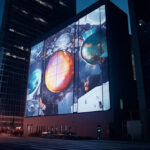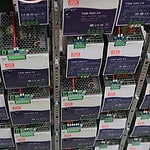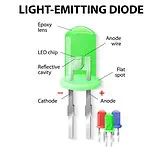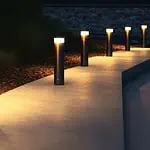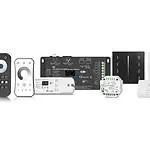If you ask me what an LED display is, I’ll show you the billboards of Time Square! – and here you got your answer. These bulky screens are bright enough to provide visibility in the scorching sun and withstand heavy wind and rain. But do all LED displays have such robustness, or are they equally bright?
The LED display’s brightness level, resolution, and size depend on its application. For instance, outdoor LED displays like billboards have higher brightness, wide viewing angle, and greater IP ratings to withstand adverse climates. But indoor LED displays will not require the same extent of robustness. The technology used in these displays also greatly impacts the performance. Besides, there are many terms, like pixel pitch, contrast ratio, refresh rate, etc., that you must know to purchase the ideal LED display for your project.
Therefore, to help you out, I’ve bought a comprehensive guideline for LED displays. Here I’ll discuss different display types, technologies, and more to choose the ideal LED display. So, without any further delay, let’s begin-
What Is an LED Display?
An LED display is a technology that uses panels of light-emitting diodes as pixels to form illuminating text, images, videos, and other visual information. It is an upgraded and more efficient replacement for LCD.
The high brightness, high contrast ratio, and energy-saving feature make LED displays the most attractive marketing tool of the present day. They are suitable for both indoor and outdoor applications. You will find these displays everywhere, including shopping malls, banks, stadiums, highways, showrooms, stations, and more. With the advancement of technology, more innovative trends have been added, including OLED, Mini-LED, HDR LED, transparent LED displays, and more.
How Does An LED Display Work?
The working mechanism of LED displays varies with the type of technology usage. For instance, some LED displays require backlight LCD panels, while others don’t. You will learn about this technology in the next segment of the article. But for now, I am giving you a primary working mechanism for LED displays.
The LED display comprises numerous red, green, and blue bulbs or chips. The combination of one red, green, and blue LED forms a pixel. And each of these LEDs is called a sub-pixel. Hundreds, thousands, and millions of these pixels form an LED display. The mechanism here is quite simple. The LED display creates millions of hues by dimming and brightening the colors of the sub-pixels.
It can form any color by mixing the basic three colors. For example, if you want a magenta color, the sub-pixel red and blue will light up, dimming the green LED. Thus magenta hue will appear on the screen. In this way, you can get any color on the LED display.

LED Display Technologies
Different types of technologies are used in the LED displays; these are as follows-
Edge-Lit LED (ELED)
LED displays with edge-lit technology have LED lights arranged around the perimeter of the display, pointing towards the center. These LED strips are placed on the sides, beneath, or around the panel LCD panel. The working mechanism of ELED technology is simple. The light from the edges shines into a light guide, directing it into a diffuser. Then this uniformly disperses the light over the screen to create the desired image without any bright spots.
Direct-Lit LED
In direct-lit LED technology, LEDs are placed behind the LCD panel instead of the perimeter-wise placement of ELED. This technology provides a better display by arranging the LEDs horizontally, following a grid pattern. This ensures the screen is lit all over the display. Besides, the light is passed through a diffuser for a more uniform lighting outcome. So, compared to ELED, direct-lit LEDs are a better technology and produce a brighter image. But it is more expensive than ELED.
Full-Array
Full-array is another LED display technology that uses a backlit system like direct-lit. But here, the difference is that more LEDs are used to cover the entire back part of the screen. Thus, it gives brighter and better color contrast than direct-lit technology. One of the worth-mentioning features of this type of LED display technology is – local dimming. With this feature, you can adjust the light output of a specific screen area. It is possible as LEDs are grouped in various zones in full-array technology, and you can control each zone separately. And with these features, this technology provides you with deeper black and brighter highlights on display.
RGB
RGB technology uses three color LEDs- red, green, and blue. Dimming and combining these colors produce different colors and hues in the display. The mechanism is simple. For example, if you want a yellow color in the display, current will flow through red and green LEDs dimming the blue one. Thus you can get millions of hues in your LED display using RGB technology.
Organic LED (OLED)
OLED stands for organic LED. In this technology, a TFT backplane is used, which has illuminating compounds like Triphenylamine or Polyfluorene. So, when electricity passes through the panel, they emit light producing colorful images on the screen.
OLED provides better performance than ELED, direct-lit, and full-array LED technology. Some major benefits of OLED include-
- Thinner than its predecessors as it does not require backlighting.
- It has an infinite contrast ratio
- The brightness of each pixel is adjustable
- Better color accuracy
- Faster response time
- Unlimited viewing angle
Quantum Dot LED (QLED)
Quantum dot LED or QLED technology is a better version of LCD-LED technology. It uses a red-green quantum dot replacing the phosphorus filter found in other LCD-LED displays. But the fun fact here is that these quantum dots don’t act like filters. When the blue light from the backlight hits the quantum dots, it produces pure white lighting. This light is then passed through sub-pixels that bring the white color to the display.
This technology solves the LED display issue of pale colorings, especially red, black, and white. And thus, QLED improves the overall image quality of the LED display. Besides, it is energy efficient and produces better color contrast.
Mini-LED
Mini-LED uses the same technology as the quantum dot LED or QLED. Here the only difference is in the LED size. The backlighting of the mini-LED contains more LEDs than the QLED. These features allow more pixel placement, better resolution, and contrast. Plus, it offers you better control over the black levels of the display that you can adjust according to your preference.
Micro-LED
Micro-LED is an upgraded form of OLED technology. In OLED organic compounds are used to produce light. But micro-LED uses inorganic compounds like Gallium Nitride. When light passes these compounds, it illuminates, creating colorful images in the display. This technology is more expensive than OLED as it produces brighter and better display quality.
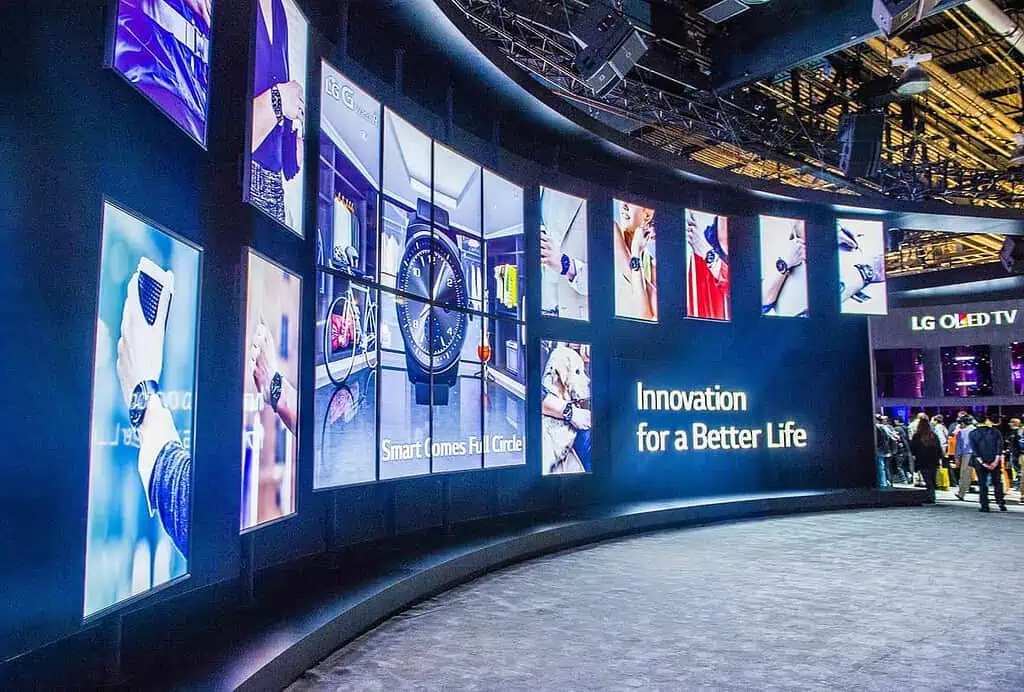
Types Of LED Display
LED displays can be of different types based on some features like- LED packages, function, or screen shape. Check out the different variants of LED displays based on these facts-
Based On The Type Of LED Packages
Different types of LED packages are used in LED displays. LED displays are of four types based on the configuration of these packages. These are as follows-
DIP LED Display
In DIP LED displays, the traditional dual-in package LED bulbs are used instead of LED chips. Looking closer at the DIP LED display, you will find dense linings of small light bulbs of red, green, and blue color. Combining these DIP LEDs, different light color images are portrayed on the display.
Features Of DIP LED Display:
- Produce a brighter image than other LED displays
- Can maintain visibility under direct sun
- Narrow viewing angle
- Not ideal for indoor LED display
Use Of DIP LED Display:
- Outdoor LED display
- Digital billboard
SMD LED Display
SMD LED displays are the most popular category of LED display. It uses surface-mounted LED chips instead of LED bulbs used in DIP displays. This technology is used in TVs, smartphones, and other lighting devices.
Here the red, green, and blue LEDs are combined into a single chip. Hence, a LED chip is much smaller than an LED bulb. So, you can insert more SMD LED chips in a display, increasing the pixel density and resolution quality.
Features Of SMD LED Display:
- Higher pixel density
- High resolution
- Wider viewing angle
Use Of SMD LED Display:
- Indoor LED display
- Retail advertising
GOB LED Display
GOB stands for glue-on board. It uses a similar technology to the SMD LED display but with a better protection system. The GOB LED display includes a layer of glue on the surface of the LED scream. This additional layer protects the display from unfavorable weather conditions like- rain, wind, or dust. Besides, it provides better heat dispersion, increasing the device’s lifespan.
GOB LED displays are ideal if you are looking for a portable LED display. They have lower maintenance costs and prevent damage due to collisions. So, you can move, install, or disassemble them without much hassle.
Features Of GOB LED Display
- Better protection
- Lower maintenance
- More durable than other LED displays
- Minimizes damage risk due to collision
- Supports transportability
Use Of GOB LED Display
- Fine-pitch LED display
- Transparent LED display
- Rental LED display
COB LED Display
COB stands for chip-on-board. It is the latest LED technology used in LED displays. It provides better display quality than SMD. Where SMD LED combines three diodes per chip, COB can combine nine or more diodes in a single chip. What is more immersive about COB LED is that it uses only a single circuit to solder these diodes. This reduces the LED failure rate and offers smooth functioning of the LED display. Besides, the high-density pixel of the COB LED display brings better resolution and brightness. It can fit 38x more LED than a DIP LED display and consumes less energy. All these facts make COB LED display a better option than other variants.
Features Of COB LED Display
- Greater screen brightness
- High pixel density
- Highest video resolution
- Low failure rate
- Better power efficiency than other LED displays
Use Of GOB LED Display
- Fine-pitch LED display
- Mini LED display
- Micro LED display
DIP Vs. SMD Vs. GOB Vs. COB LED Display: Comparison Chart
| Criteria | DIP LED | SMD LED | GOB LED | COB LED |
| Number of diodes | 3 diodes(Red LED, Green LED, & Blue LED) | 3 diodes/LED Chip | 3 diodes/LED Chip | 9 or more diodes/LED chip |
| Lumens/Watt | 35 – 80 lumens | 50 – 100 lumens | 50 – 100 lumens | 80 – 150 lumens |
| Screen Brightness | Highest | Medium | Medium | High |
| Light Efficiency | Medium | High | High | Highest |
| Viewing Angle | Narrow | Wide | Wide | Wide |
| Heat Dispersion | Medium | High | High | Highest |
| Pixel Pitch | P6 to P20 | P1 to P10 | P1 to P10 | P0.7 to P2.5 |
| Protection Level | High | Medium | Highest | High |
| Price | Medium | Low | Medium | High |
| Recommended Application | Outdoor LED display, Digital billboard | Indoor LED display, Retail advertising | Fine-pitch LED display, Transparent LED display, Rental LED display | Fine-pitch LED display, Mini LED display, Micro LED display |
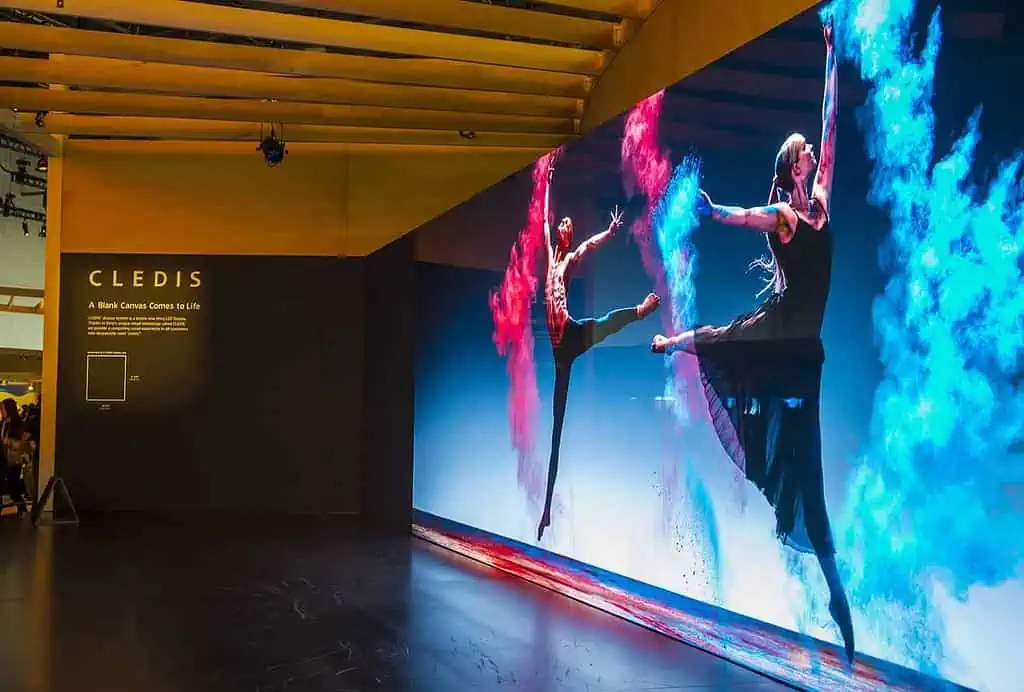
Based On The Function
Based on the function and usage of LED displays, they can be divided into five types; these are as follows-
Text Display LED
Have you noticed the “Open/Close” LED displays in front of the restaurants? This is a brilliant example of text display LEDs. This type of display only supports alphabets and alphanumeric information. They are programmed to display definite texts, so you can not change them.
Image Display LED
Image display LEDs have more advanced technology than text display LEDs. They include both text and images in static form. This technology uses two screens to display images. The still image billboards on streets or highways are examples of image display LEDs.
Video Display LED
Video display LED refers to the displays that support the motion of images. Here numerous high-pixel LEDs are installed to bring videos of higher resolution. The modern billboard you see on the billboard of Time Square is an example of a video display LED.
Digital LED Display
The digital display is similar to a text display LED. The only difference is that digital displays support only numerical numbers, whereas text displays can show numbers and letters. You will find digital displays on the currency display boards of banks or in digital clocks. They are made of seven-segment nixie tubes that illuminate in red or orange to give different numerical shapes.
LED Lattice Image Text Display
A LED lattice image text display supports image and text simultaneously. Here the text keeps in motion, but the image stays static. This type of display is used in places where the motion of the text is required. For instance, you will find LED lattice image texts on the gates of airports showing flight timings. Again, the statistics you see in the stadium display also fall under this category.
Based On Screen Shape
You will see the LED displays in different shapes. Based on this, I have categorized the LED display into three sections-
Flat-shaped LED Displays
Flat-shaped, also known as standard displays, are the most common category of LED display. They have a thin surface comprising a series of light-emitting diodes to produce high-resolution displays. The bright image-generating capability of these displays makes them suitable for indoor and outdoor use.
Curved LED Display
The flat displays with bent corners are called curved LED displays. They form a concave surface that provides viewers with a greater and broader viewing angle. The most amazing feature of this type of display is its adjustable capability to the audience’s peripheral vision. Besides, they have more depth, creating more attractive visuals than flat-shaped displays.
Flexible LED Screen
Flexible LED screens are known for their highly customizable features. They give manufacturers the freedom to structure the display screen in various shapes. The mechanism behind the flexibility of this display is the attachment of LED chips with PCB or other bendable materials like rubber. They have an insulating substance on both sides to protect the display’s circuit. Besides, flexible LED displays are straightforward to use and maintain.

Application Of LED Display
LED displays are suitable for both indoor and outdoor uses. Their most common applications are as follows-
Meeting Room
LED displays are used in meeting rooms to present presentations and other survey reports. It is an advanced replacement for traditional projectors or whiteboards. The advantages of using an LED display in a meeting room include-
- Suitable for all meeting room sizes, big or small
- Provides high-resolution pictures
- Enhanced screen visibility
- Requires less maintenance than traditional display
- Better meeting experience
Retail Advertising
Instead of using sign boards and printed banners, you can use LED displays for advertising. Such an attempt will highlight your product with colorful visuals. Thus, you can spread your brand message to the customer with an attractive presentation. The plus points of using the LED display in a retail store are-
- Creates customer engagement
- Enhances your brand reputation
- Eliminate printing cost
- Easy installation and maintenance
Digital Billboards
LED displays are used as digital billboards for outdoor advertisement. DIP LED, or OLED displays have enough brightness to ensure visibility in scorching sunlight. Besides, GOB displays have higher protection levels to resist rain, dust, and other weather conditions. All these features make LED displays an excellent option for billboards.
- Displays advertisements using text, attractive images, videos, and dynamic visualization.
- Low maintenance than traditional billboard
- One display can be used for multiple advertisements
- Grab customers’ attention quickly
Sports Arena or Stadium
LED displays are used in the stadium to present the scoreboard, showing match highlights, team rosters, and advertisements. LED displays’ higher resolution and brightness make them suitable for sports areas.
- Audience from a distance can watch the match on an LED display
- LED displays are available in a large size that covers better viewing angles in the stadium
- Offers advertisement opportunity
- Increase public engagement and makes the match more exciting
Film or TV production
LED displays are widely used as the background of TV production, films, and other live shows. It offers the audience an enriched visual experience. The reason for using the LED display for this sector includes-
- Green screens can be replaced with LED displays to provide “realistic” backdrops.
- Allows showcasing graphics and information during live shows.
- You can use an LED display to show any background created by a computer. This will save you time and cost of studio setup.
- Give viewers a rich, engaging watching experience.
Hotel Ballroom
A hotel ballroom is a busy area where business meetings, wedding functions, and other events are organized. Installing an LED display in the hotel ballroom allows you to display the hotel’s best interiors and views, booking details, event timing, and more. Besides, it eliminates the cost of traditional printed backdrops.
Building Lobby
Installing an LED display in your building lobby makes the building management system much easier. It creates a modern ambiance for your building. The benefit of using the LED display in the building lobby includes –
- Give visitors a memorable welcome experience.
- Increase the building’s worth.
- You can use the LED display for announcements.
Glasses-free 3D LED screen
In this digital age, marketing plays a crucial role. In this case, a glasses-free 3D LED display is a brilliant tool. Audiences can have a 3D experience of your product and take pictures and video clips. And sharing these visuals can be a great marketing strategy for your brand.
Sales Gallery
Real estate owners employ LED displays in their stores to showcase product information with vibrant visuals. This works effectively to grab customers’ attention and boost return on investment (ROI).
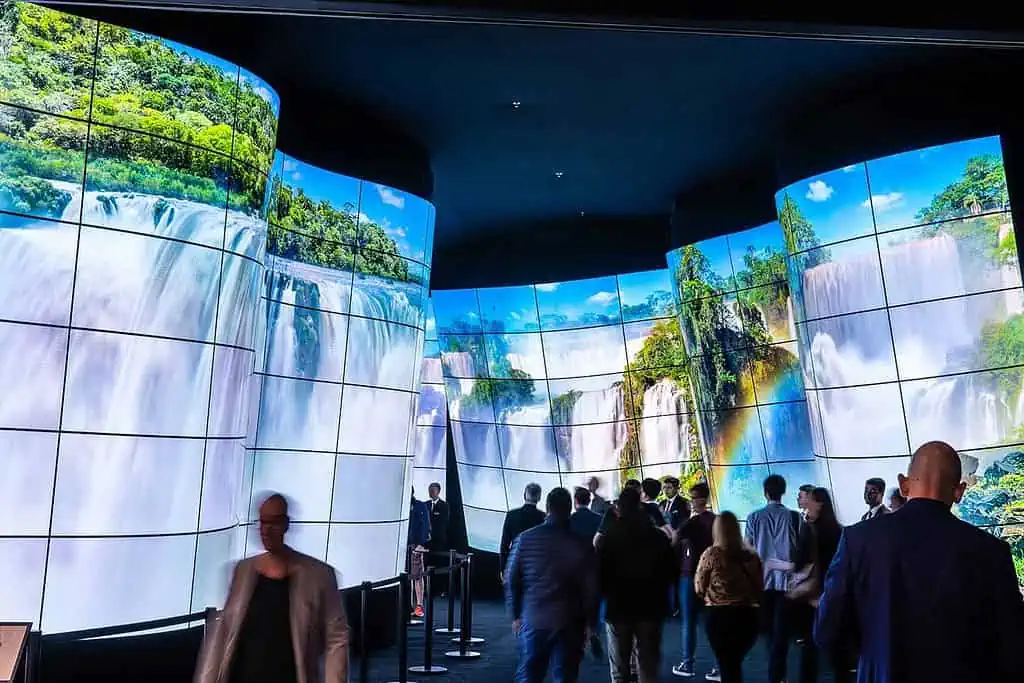
Advantages Of LED Display
LED display has countless benefits; some are as follows-
- High-Quality Images: LED displays offer you different levels of resolution. With the increase in pixel density, the image quality of the display increases. They can also keep their visibility in scorching sunlight.
- Energy-efficient: One of the most impressive features of LED displays is their energy efficiency. You will be shocked that an LED display consumes 10 times less energy than an incandescent bulb. So, turning on an LED display all day will not cost you heavy on your electricity bills.
- Intensity & brightness: LED display is bright enough to support outdoor lighting. Even in the scorching sunlight, you can see these displays.
- Range of color: A full-color LED display provides more than 15 million colors. So, if you want high color contrasts, nothing can beat an LED display.
- Longer lifespan: LED displays can run for 100,000 hours! That is, you can use a display for more than ten years. But here, proper maintenance and working environment matter.
- Lightweight: Compared to traditional displays, LED displays are far more lightweight. They have to think of screens and consume less space than traditional ones. And these features allow you to fit them anywhere. You can also transport them according to your needs.
- Available in different shapes & sizes: LED display comes with a versatile range. You will find them in all sizes. Whether you need a small or big display, they can serve your purpose. And for shapes, you can choose a flat or curved screen as far as your preference.
- Easily programmable: LED display supports internet connection. So, you can control and turn on/off the device from anywhere.
- Great viewing angles: Purchasing a LED display with a higher viewing angle allows you to create visibility up to 178 degrees. This is what makes the LED screen provide you visibility from all angles.
- Short response time: LED displays have a very short response time. They can quickly turn off/on or switch to the next image. These features work great for sports broadcasting, high-speed videos, news broadcast, and more.
- Reduced eye strain: The technology of LED display offers flicker-free performance. This reduces eye strain or fatigue.
- Easy installation & maintenance: LED displays are waterproof, dust-proof, and anti-corrosion. So you can maintain it easily. Besides, the installation process is also simple.
- Environment-friendly: Unlike other lighting technology, LED displays don’t produce any harmful gas like mercury or ultraviolet rays. Besides, they consume less energy and don’t get overheated. LED displays require less maintenance and repair, resulting in less parts production.
- Enhances branding and reputation: Installing LED displays lets you showcase your product with appealing visuals. It helps the customer to remember your product for a long time and thus enhances the brand’s reputation.
Disadvantages Of LED Display
Besides the advantages of LED display, it also has some drawbacks. These are as follows-
- Causes Light Pollution: LED display produces higher brightness to ensure visibility in the daytime. But the problem here is that it also creates the same brightness level at night. This excess brightness causes light pollution at night. However, considering the surrounding area, you can solve this issue using a light sensor that will automatically adjust the screen’s brightness.
- Expensive: LED displays are more expensive than traditional banners or printed displays. It requires LED panels, controlling systems, and electricity bills, which makes the technology expensive.
- Prone to defects: LED displays are more porn to defects and damage. And to avoid this situation, proper engineering is essential.
- Gradual color-shift: With time, LED displays show color-shift issues. This problem is major with white color; LED displays often fail to bring pure white.
Terms To Know About LED Display
I have listed some terms about LED displays that you must know to get an idea about the quality of the display. Learning these terms will also help you to find out your requirements and select the ideal display for your project.
Pixel Pitch
Pixel pitch refers to the distance between two pixels measured in millimeters (mm). A lower pixel pitch means there is less space between the pixels. This leads to higher pixel density providing better picture quality. Pixel pitch is denoted by ‘P.’ For example- if the distance between two pixels is 4 mm, it is called a P4 LED display. Here I have added a chart for your better understanding-
| Naming Of LED Display (Based on pixel pitch) | Pixel Pitch |
| P1 LED Display | 1mm |
| P2 LED Display | 2mm |
| P3 LED Display | 3mm |
| P4 LED Display | 4mm |
| P5 LED Display | 5mm |
| P10 LED Display | 10mm |
| P40 LED Display | 40mm |
Resolution
Resolution refers to the number of pixels displayed on an LED screen. This term directly relates to picture quality. Suppose you have a big screen with low resolution and a small screen with low resolution. Which one gives a better display? Here the size of the screen doesn’t relate to image quality. Higher resolution means more pixels and better image quality. So, it doesn’t matter how small a screen is; if it has a better resolution, it will provide a better image.
The video resolution of the LED display has two numbers; one shows the number of pixels vertically and the other horizontally. For example- a LED display with HD resolution means 1280 pixels are displayed vertically and 720 pixels horizontally. Based on this resolution, LED displays have different naming. Check out the below chart to get a better idea-
| Resolution | Pixel Number (Vertical x Horizontal) |
| HD | 1280 x 720 |
| Full HD | 1920 x 1080 |
| 2K QHD | 2560 x 1440 |
| 4K UHD | 3840 x 2160 |
| 5K | 5120 x 2160 |
| 8K | 7680 x 4320 |
| 10K | 10240 x 4320 |
Viewing Distance
The distance up to which the visibility of the LED display or the picture quality is maintained is known as the viewing distance of the LED display. To get the best viewing distance, consider the pixel pitch. For a smaller pixel pitch, the minimum viewing distance will be shorter. So, it is better to select an LED display with a small pitch pixel for a small room.
The minimum viewing distance of an LED display is equal to the digit of the pixel pitch. For example- if a LED display has a 2 mm pixel pitch, the minimum viewing distance is 2 m. But what is its optimal viewing distance?
To get the optimal viewing distance, you need to multiply the minimum viewing distance by 3. So, the optimal viewing distance of the LED display,
Optimum viewing distance = minimum viewing distance x 3 = 2 x 3 = 6 m.
| LED Display | Pixel Pitch | Minimum Viewing Distance | Optimum Viewing Distance |
| P1.53 Fine Pitch Indoor LED Display | 1.53 mm | >1.53 m | >4.6 m |
| P1.86 Fine Pitch Indoor LED Display | 1.86 mm | >1.86 m | >5.6 m |
| P2 Indoor LED Display | 2 mm | >2 m | 6 m |
| P3 Indoor LED Display | 3 mm | >3 m | 9 m |
| P4 Indoor LED Display | 4 mm | >4 m | 12 m |
| P5 Indoor LED Display | 5 mm | >5 m | 15 m |
| P6.67 Outdoor LED Display | 6.67 mm | >6.67 m | >20 m |
| P8 Outdoor LED Display | 8 mm | >8 m | >24 m |
| P10 Outdoor LED Display | 10 mm | >10 m | >30 m |
Viewing Angle
The viewing angle of the LED display determines the maximum angle at which the audience can enjoy the view, keeping the quality constant. But you may question how viewing angle affects the picture quality.
If you are watching TV from the center, the viewing angle won’t matter the picture quality. But what if you are watching from the off-center? In this case, if the viewing angle is less, then the display will look dark. To solve this issue, LED displays with greater viewing angles are used in outdoor billboards. For example- the LED display in retail malls has a greater viewing angle. So the moving audience can experience high-quality visuals from all directions.
178 degrees (vertical) x 178 degrees (horizontal) is taken as the widest view angle for an LED display. However, view angle ranging from 120 degrees to 160 degrees provides a considerable display quality for general purpose.
Refresh Rate
The refresh rate of an LED display refers to the number of times an image is updated or refreshed per second. It is determined using the unit Hertz (Hz). For example, the refresh rate of an LED display is 1920 Hz means in one second; the screen draws 1920 new images. Now you may question why a higher refreshing rate is necessary.
To check the refreshing rate of your LED display, open your phone’s camera and record the screen. If the display has lower refreshing rates, you will find more black lines in the recorded video or captured photos. This lining will make the displayed content look ugly, which can hamper public engagement. So, never underestimate the advantages of having higher refresh rates. Here are some tips following which you can get a higher refresh rating-
- Get a high refresh rate LED display module.
- Choose a high-end driving IC.
- Use an efficient LED control program for operating your LED display.
Brightness
The brightness of the LED display is measured in nit. A higher nit value indicates a brighter LED screen. But is a brighter display always a good choice? The answer is a big No. You need to analyze the application requirement before choosing the brightness. For instance, if you want an LED display for indoor uses, it will work great in 300 nits to 2,500 nits. If you go above this range, it can cause eye strain and headaches due to over brightness. Again, the brightness level should be higher if you want a LED display for the stadium. Here is a chart with recommended brightness levels for different applications-
| Application | Recommended Display Brightness |
| Indoor | 300 to 2,500 nits |
| Semi-Outdoor | 2,500 to 5,000 nits |
| Outdoor | 5,000 to 8,000 nits |
| Outdoors with direct sun exposure | Above 8,000 nits |
Contrast Ratio
The contrast ratio of LED displays measures the brightness ratio difference between the darkest black and the whitest white. This ratio indicates the capability of the LED display to provide saturated and vibrant color quality. A higher contrast ratio means better picture quality. A LED display with 1000:1 means the brightness level of full black is 1000 times lower than the brightness of full white. A low contrast ratio hampers the content appearance by making them look grayish and unsaturated. So, to ensure proper visuals, you must go for LED displays with a higher contrast ratio.
How To Choose The Best LED Display? – A Buyer Guide
You have already learned about the basic features and terms of LED display from the above section. Now, I’ll guide you on choosing the best LED display-
To save your time, you can check Top 10 LED Display Manufacturers in China.
Consider The Location – Indoor/Outdoor
The location of the LED display is an important consideration in deciding the brightness level. If you install the display indoors, a lower brightness level will work, but consider the lighting availability inside the room. Again, if the display is for outdoor use, go for higher brightness depending on its exposure to the sun.
Determine Screen Size Requirements
The LED screen size depends on room size, resolution, and pixel pitch. Screen size is measured as the width x height of the LED display. But the ideal size differs with the variation of resolution. However, there is a basic rule for finding out the ideal screen size for an LED display:
Ideal Screen Size (m) = (Resolution x Pixel Pitch) ÷ 1000
For example, if a LED display has a pixel pitch of 3 mm, then the required screen size will be-
- For HD (1280 x 720):
Width of the screen = (1280 x 3) ÷ 1000 = 3.84 m
Height of the screen = (720 x 3) ÷ 1000 = 2.16 m
Recommended Screen size = 3.84 m (W) x 2.16 m (H)
- For Full HD (1920 x 1080):
Width of the screen = (1920 x 3) ÷ 1000= 5.760 m
Height of the screen = (1080 x 3) ÷ 1000 = 3.34 m
Recommended Screen size = 5.760 m (W) x 3.34 m (H)
- For UHD (3840 x 2160):
Width of the screen = (3840 x 3) ÷ 1000 = 11.52 m
Height of the screen = (2160 x 3) ÷ 1000 =11.52 m
Recommended Screen size = 11.52 m (W) x 11.52 m (H)
So, you can see that the screen size differs for the same pixel pitch for the resolution variation. And the same will happen to keep the resolution the same and decrease or increase the pixel pitch..
Therefore, when you purchase an LED screen, consider the pixel pitch and resolution. Besides, the size of the room is also a crucial factor to consider here.
IP Rating
IP rating determines the protection level of the LED display. It contains two digits defining the degree of protection, one for solid ingress and the other for liquid ingress. A higher IP rating means better protection against collision, dust, wind, rain, and other weather conditions. But is a higher IP rating always necessary? No, you need to consider the application to decide on the IP rating. If you install the LED display indoors, going for a higher IP rating will be a waste of money. But for outdoor conditions, for example- installing billboards, you need greater protection. In this case, the LED display should have an IP65 or at least IP54. Going for IP65 will protect your LED display from dust, heavy rain, and other solid objects. To know more about IP rating, check this article- IP Rating: The Definitive Guide.
Compare Features & Quality
When purchasing an LED display, you will face different terms to judge the quality. But first, you need to know your requirements and then match them with the products you want to buy. Here are some short tips that you should implement to choose the best quality-
- Choose an LED display with a higher resolution to get better visual quality.
- A higher contrast ratio will provide more vibrant colors and saturated image quality.
- Go for higher refresh ratings for smooth motion and lower screen flicker issues.
- Choose a viewing angle, considering your application. A lower viewing angle will work if the target audience faces the center, for example, an LED display in a meeting room. But if the LED display is installed targeting a moving audience, like a display in a retail mall, go for a higher viewing angle.
Energy Consumption
The energy consumption of LED displays depends on many factors, including the technology used, brightness, and screen size. The application of the LED display also greatly impacts power consumption. For instance, having the same brightness level, an outdoor LED display consumes more energy than an indoor one. Check the chart below to get a better idea about energy consumption-
| Display Type | Energy Consumption (W/m) | Max Brightness Level (nits) |
| P4 Indoor LED Display | 290 | 1800 |
| P6 Indoor LED Display | 290 | 1800 |
| P6 Outdoor LED Display | 375 | 7000 |
| P8 Outdoor LED Display | 400 | 7000 |
| P10 Outdoor LED Display | 450 | 7000 |
| P10 Energy Saving Outdoor LED Display | 200 | 7000 |
So, from the above chart, you can see the power consumption for outdoor LED displays is higher. And with the increase of pixel pitch, the energy consumption increases. That is better with the resolution of higher electricity it requires. However, going for an energy-saving option can save your electricity bills.
Check The Warranty Policies
Most LED display manufacturers provide a warranty for 3 to 5 years. But usually, LED displays are durable enough to last more than seven years if proper maintenance is done. Yet you should check the terms and conditions and service-providing facilities before purchasing.
Installation Methods Of LED Display
You can install a LED display in several ways based on its application. For instance, an outdoor LED display installation is more challenging than an indoor one. Besides, you must build a more robust structure for outdoor LED displays to withstand adverse weather conditions like storms and wind. But with indoor LED display installation, these factors are not considered. Below I have listed out different installation methods of LED display for indoor and outdoor applications. Go through these processes and choose the one that suits your application category best.
Wall Mounted Installation
Wall-mounted LED display installation is suitable for both indoors and outdoors. For indoor installation, you will need to mount brackets into the wall. Consider the weight of the LED display to ensure the brackets are strong enough to support the screen. But, for outdoor installation, like digital billboards, you will require a customized steel frame to mount on the building wall. A maintenance platform is built between the display and the wall for maintenance. However, in indoor applications, the front maintenance system is adopted.
Wall Embedded Installation
If you want to give your LED display a neat look, go for a wall-embedded installation method. The display is mounted within the wall with a front maintenance system in this process—this type of mounting suits indoor and outdoor applications. But the installation is quite challenging as the engineers must calculate the appropriate depth to embed the screen.
Ceiling Hung Installation
You must have observed the hanging displays in railway stations, basketball stadiums, or other event venues. This installation category works best for indoor applications with heavy foot traffic. But here, you must consider the strength of the ceiling to hold the weight of heavy LED displays to avoid any unexpected accidents.
Pole Installation
Pole installations are suitable for LED billboards. Such a structure is very expensive as you must build a concrete foundation to set the poles. The process includes testing soil strength, wind load, and more. The height of the poles is an important consideration here for not disturbing the surrounding infrastructure. The greatest advantage of pole installation is visibility. As the LED displays are installed at a great height, people from far can see the displayed content. However, there are two types of pole installation based on the size of the LED display-
- Single-pole installation for small LED display
- Double-pole installation for large LED display to ensure stronger support
Roof Installation
Roof installation is a great choice to increase the visibility of displaying content. You will see this installation category in urban areas with large buildings. But the wind load is the most challenging situation that engineers face in a roof installation. In pole installation methods, the LED displays have a more robust setup than roof installation. But yet, roof installation is cheaper than the pole method as you will not require to build a concrete foundation. However, you should consider the structure of the building and its capability of holding the screen weight.
Mobile LED Display
Mobile LED displays are the latest form of advertisement. In this process, LED screens are installed in the vehicles. As the vehicle travels, it spreads the message of the display content to many people. Thus, this type of installation is getting popular day by day.
Factors Affecting Lifespan Of LED Display
Though LED displays have durable and long-lasting technology. Yet some factors directly affect its lifespan. These are as follows-
- Ambient Temperature & Heat Dissipation
Ambient temperature greatly affects the mechanism of LED displays. If the ambient temperature is high, it increases the working temperature of the displays. Which eventually overheats the LED display, lowering the lifespan of the internal component. An efficient heat dispersion method is essential to avoid such a situation. For example, you can install a fan or air conditioner to prevent overheating. Surface radiation treatment is also a great option to keep the temperature down.
- Power Supply
The power consumption of LED displays is different for indoor and outdoor applications. You must have a well-tuned display configuration and appropriate installation to ensure a proper power supply. This will help you to get the maximum power output without affecting its lifespan.
Differences Between LED and LCD Displays
The LCD is the predecessor of LED display technology. Despite its many disadvantages, LCD is still a strong competitor of LCDs. The cheap pricing of LCD technology is one of the main reasons for its popularity.
- LED displays use light-emitting diodes to produce images. LCDs, on the other hand, use liquid crystals to generate illumination.
- LED displays can produce light independently and don’t depend on external lighting. But LCDs depend on external light, which questions their picture quality.
- For outdoor installation, brightness is a crucial factor to consider. And LED displays can provide much higher brightness levels in comparison to LCDs. This feature makes LEDs a superior option for outdoor display.
- LED displays have a higher contrast ratio than LCDs. So, using an LED display, you will get more vibrant colors, better highlights, and color accuracy.
- LCDs may not be ideal for moving foot traffic places as they have narrow viewing angles. But installing an LED display will work here. They have a wide viewing angle ranging up to 178 degrees, both vertical and horizontal. So, audiences from any angle can enjoy displaying content properly.
- LED technology has the lowest energy consumption than other lighting systems. And so, LED displays will be a better option over LCD if you want an energy-saving feature.
- The LED display has thinner module bezels providing you with a seamless experience. But your viewing experience with LCDs is hampered as they have narrow visible bezels.
- In terms of life span, LED displays last longer than LCDs. They can run for over 100,000 hours. However, this durability may be interrupted due to inadequate maintenance.
LED Display Vs LCD display: Comparison Chart
| Criteria | LED Display | LCD Display |
| Lighting Technology | Light Emitting Diodes | Liquid Crystal with backlighting |
| Contrast Ratio | High | Medium |
| Viewing angle | Wide | Narrow |
| Power consumption | Low | Medium |
| Screen Brightness | High | Medium |
| Color Accuracy | High | Medium |
| Bezel | Bezel-less | Thin visible bezels |
| Lifespan | Long | Medium |
| Cost | High | Medium |
LED Vs OLED Displays – Which Is Better?
OLED is one of the newest LED display technologies. Where traditional LED displays require backlighting, OLED doesn’t. One of the significant differences between this technology is in the mechanism. OLED displays have organic compounds that illuminate when electricity passes through them. But LED displays don’t have organic compounds.
In terms of performance, OLED provides better cooler accuracy and wider viewing angle than LED display. Besides, using an OLED display, you can control the brightness of individual pixels. And this feature offers you an infinite contrast ratio. So, undoubtedly the OLED display has better technology than LEDs. And this is the reason it is much more costly.
Indoor LED Display Vs Outdoor LED Display
Indoor and outdoor LED displays have numerous differences to consider. However, the major distinction criteria are as follows-
| Criteria | Indoor LED Display | Outdoor LED Display |
| Definition | The LED displays installed in indoor areas are called indoor LED displays. | Outdoor LED displays refer to the displays installed in outdoor areas. |
| Size | This type of LED display is usually small and medium in size. | They are mostly bulky in size. |
| Brightness | Indoor LED displays have less brightness level than outdoor ones. | As outdoor LED displays face direct sun exposure, they have higher brightness levels. |
| IP Rating | IP20 or above is enough for an indoor LED display. | They need a higher IP rating of IP65 or at least IP54 to withstand rain, wind, dust, and collision. |
| Waterproofing | Indoor LED displays don’t require waterproofing as they don’t face adverse weather conditions. | As outdoor LED displays face rain and storms, it requires waterproofing. |
| Ease Of Installation | Installation of indoor LED displays is simple. | Outdoor LED displays are difficult to install. |
| Maintenance Level | They are easy to maintain. | This type of LED display is hard to maintain. |
| Power consumption | Indoor LED displays consume less power than outdoor displays. | As outdoor displays are larger in size and produce brighter images, they consume more power. |
| Viewing Distance | The indoor display has less viewing distance. | The viewing distance of outdoor LEDs is more to ensure maximum visibility. |
| Price | The price of these LED displays is lower than outdoors. | As outdoor LED displays require better protection, higher image quality, and robust installation, they are much more expensive. |
| Application | Bank countersMeeting roomHall BallroomBuilding lobbysupermarket promotion display boards | Billboard Stadium scoreboard Retail advertisement |
Future Trends and Innovations in LED Displays
LED displays have already taken the advertising sector to storm. But with the development of technology, more advanced trends and innovations are evolving in LED displays. Some of these are as follows-
HDR (High Dynamic Range) Displays
HDR, or High Dynamic Range technology, takes the digital display experience to the next level. The improvement of HDR display will bring-
- Higher resolutions, such as 8K and beyond
- Better contrast and more accurate HDR rendering
- Wider color gamuts
- Higher brightness levels and improved contrast
- Auto brightness adjustment
Curved and flexible displays
Though not new, curved and flexible displays are a growing trend in LED displays. Although flat displays are standard, curved and flexible displays have several special benefits that a flat display cannot provide.
Both curved and flexible LED displays offer advanced capabilities over flat displays. Curved screens provide the audience with a better viewing experience. Contrarily, flexible displays work great when typical displays can’t be installed, such as curving walls or oddly shaped areas. We may anticipate seeing more innovative designs, including curved and flexible LED displays, as these technologies develop.
Transparent & translucent LED display
Transparent and translucent technology are the most innovative approaches to LED displays. They offer a see-through view through the screen. Implementing this technology provides your space with a more high-tech and modern approach. In the upcoming days, this will be more common in applications like retail, architectural displays, and digital signage. For more information, you can check What Is a Transparent LED Screen and How Does It Work?
Increased resolution and pixel density
The resolution is getting better and better day by day. This trend is derived from the increasing demand for LED displays such as signage, billboards, and more. With better resolution, the quality of LED displays will improve, providing more defining visuals. This will meet the demand for a growing visual presentation. So, there is no doubt that with the increase of pixels, the resolution of LED displays will improve soon.
Integration with AI and IoT
LED displays integrating artificial intelligence (AI) and Internet of Things (IoT) technologies are a remarkable trend. Compared to conventional screens, these can offer a more immersive experience to interact with virtual surroundings more naturally. This will bring smart features to LED displays, including-
- Voice control
- Motion control
- Automated content optimization based on viewer preference
- Real-time data integration for dynamic content display
Troubleshooting LED Display
Like other devices, LED displays can sometimes break down or may not function properly. To face such a situation, you should know about the basic issues of LED displays. Here I have listed the most common problems with LED displays and some tips to solve them-
Missing Color in the Module
In some cases, the module may not have any color. This can happen due to loose or damaged cable. Try plugging and unplugging several times to check if it works. If not, replace the cable. But if an outdoor LED display shows such an issue, fixing it can be very challenging. So, the safer option is to contact the service tech ASAP.
Receiving Card Failure
The receiving card in each region collects data from the controller and delivers it to various panels to create the overall image. If the receiving card is defective, it will fail to address the correct panel. This will eventually fail to form an image accurately. You can repair the faulty receiving by simply repairing it or replacing it with a new one.
Power Supply Failure
Check the power supply if any certain section of the display or the entire screen becomes dark. Ensure the circuit is on point and the connection is accurate. If the issue doesn’t solve, contact a skilled technician to fix the issue.
Module Failure
Sometimes the module may not be sufficiently dark or bright. If your LED display shows such an issue, check whether the line connection between the normal and defective modules is in good shape. If not, repairing the faulty cable will solve the problem.
Controller Failure
LED displays form images by receiving data from the controller. If there’s any failure in the controller, the receiver card won’t be able to pass information to the LED panels. It can be caused due to a fault in the cable connection or a controller defect. Check all the connections and restart the display to see if it works. Contact a technician if you can’t fix it.
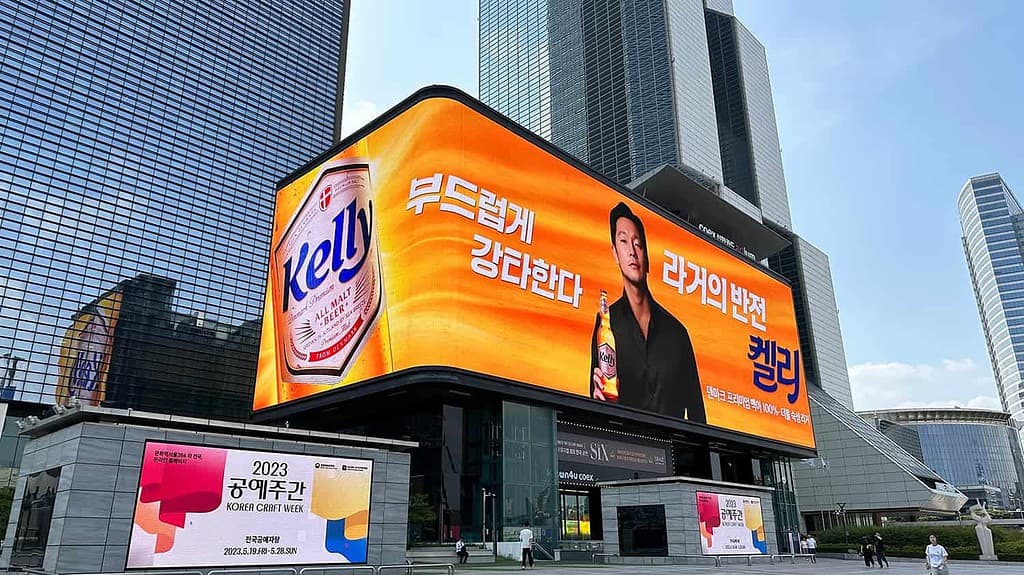
FAQs
A gentle wipe with a microfiber cloth is enough for regular LED display cleaning. But if the screen becomes too greasy, you can use a wet cloth to clean it. Never spray any liquid directly into the display; it can damage the screen if it has a lower IP rating. Besides, you should always turn off the LED display and unplug it to avoid any unexpected accidents. And if you are using a wet cloth for cleaning, ensure the display is dry before turning it on.
Nope, LED displays have better technology than LCDs. Installing an LED display, you will get better color contrast, wider viewing angle, and higher brightness level enhancing the viewer experience. In contrast, LCD uses more energy and has thin bezels that hampers the viewing experience. Besides, it has a lower lifespan than LCDs. And for these facts, LED displays are better than LCDs. But the only plus point with LCD is its affordable pricing compared to expensive LED technology.
LED displays can run from 60,000 hours up to 100,000 hours. That means keeping the device on for 6 hours a day can make the device last for 45 years! However, maintenance plays a key role in the durability of LED displays. And some factors like ambient temperature, heat dispersion, and power consumption also affect its lifespan.
LED displays use light-emitting diodes for light production. This technology uses 60 to 70 times less energy than other forms of lighting like halogen or fluorescent. Besides, unlike its predestined LCD, LED display is much more energy efficient.
The heat of sunlight significantly affects the LED display. Due to excess heat, the ambient temperature of the LED display increases resulting in overheating. This situation can damage the inner component of the display, causing display failure. To solve this issue, you should implement a proper heat dispersion system when installing LED displays outdoors or in any area with direct sunlight exposure.
LED displays use energy-efficient technology. Theoretically, LED pixels work 5V using 20mA. That means the power consumption of each pixel is 0.1 (5V x 20mA). However, its power consumption depends on factors like- the brightness level, the type of LED technology used, and the manufacturer’s design.
The brightness of LED displays depends on the application. If you install it indoors, it will require lower brightness; outdoors, it will require a higher brightness level. The brightness exceeding the required level can cause eyestrain and headache. Besides, high-brightness LED displays are expensive. So, getting a high-brightness LED display where it is unnecessary is a waste of money.
The Bottom Line
LED displays are the most effective medium for advertising and visual presentation. You can increase your brand value by installing these displays and giving the audience an outstanding visual experience.
The LED display uses different types of technology; some are suitable for indoors, while others are for outdoors. However, to choose the ideal one, you should consider pixel pitch, resolution, viewing angle, contrast ratio, and more. Besides, sunlight exposure to the screen should also be considered to get the right brightness level for your LED display. For instance, indoor lighting requires less bright display than outdoor display. Again for semi-outdoor LED displays, the brightness should be lower than outdoors as they don’t face direct sunlight.
Lastly, with the advancement of technology, LED displays are creating a widening opportunity to bring innovation to the advertising industry. So, hold your breath and prepare to witness the future of LED displays.

